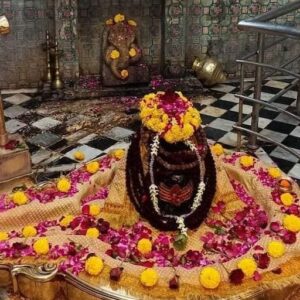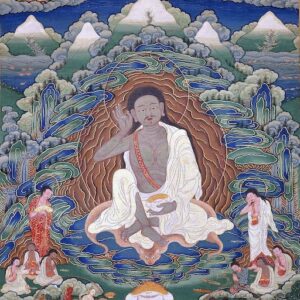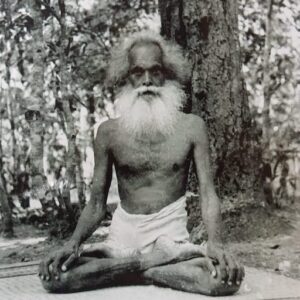This is a samadhi of Swami Chinmayananda Saraswati.
There is a place to sit and meditate. You can go into meditative states here effortlessly.
How to Get there
The samadhi is within the Chinmaya Tapovanam ashram, The temple is 13.4 kms North of Kangra.
Map:
https://maps.app.goo.gl/61f5vgeosYS6uEEv6
About Chinmayananda Saraswati
His Early Journey – how it all began
On 8 May 1916, a child was born as so many other children were born. Born to ordinary parents – a lawyer father, a home maker mother, Balan went to school like all kids do; he would later acquire a degree in English Literature, plunge into the Freedom Movement of India against British rule, be imprisoned, fall frightfully ill, be thrown out of jail for that, be rescued by a strange lady, start writing for a newspaper, make fiery speeches and plan even more fiery exposes and then, all too suddenly abandon all that, for none of them explained to him the purpose of his birth.
Clearly, Swami Chinmayananda was an unusual young man.
Swami Sivananda’s ashram in Rishikesh.
How unusual is the hand of God! Unwittingly at the door of India’s finest spiritual teacher, Balakrishnan’s journey began to reveal to him his own inner spiritual revolution and evolution. Swami Sivananda’s divinity, love, and Vedanta teachings overwhelmed the young skeptic. A striking inner transformation unfolded within Balakrishnan and instead of questioning and confronting the world outside, he began to confront his inner world of thoughts and ideas. He began questioning and reflecting upon the purpose of life and the secret of permanent happiness. In the company of saints, and through the clarity of their teachings, the highly intellectual seeker soon chose to become a renunciate himself.
On the holy day of Mahashivaratri, February 25, 1949, Balakrishnan was initiated into the sannyasa order by Swami Sivananda, who blessed him with the name ‘Swami Chinmayananda Saraswati’. Chinmayananda means ‘filled with the bliss of pure Consciousness’. Swami Sivananda then guided Chinmayananda to the most renowned Vedanta master of the time, Swami Tapovanam, who lived in Uttarkashi, in the Himalayas. Swami Tapovanam who rarely took on disciples put forth strict conditions… but these were no deterrent for the young renunciate; he accepted each of his Guru’s terms, unconditionally.
Thus began a period of intensive study and austere living as Swami Tapovanam’s disciple.
Work & Legacy
Swami Chinmayananda conducted his first Jnana Yajna (a series of spiritual discourses) in December 1951, at a small temple in Pune, Maharashtra. Jnana Yajna, a term he coined from Lord Krishna’s teachings in the Shrimad Bhagavad-gita, refers to the student who through scriptural studies performs the ritual of worship (yajna) at the altar of wisdom (jnana).
His teachings were based on the authority of the Vedas and his own direct experience. They were highly appreciated, and the number of devotees eager to learn from Swami Chinmayananda’s powerful, dynamic, yet logical, and witty discourses increased rapidly. An inspired band of devotees thus formed ‘Chinmaya Mission’ on August 8, 1953.
Understanding the needs of the people came naturally to Swami Chinmayananda. For each individual – young or old – the knowledge solutions he had were the same, but he packaged them differently for each segment. These then grew to becoming the core anchors for growth.
Study or Swadhyaya: Built both as self-study and group study, Swami Chinmayananda inculcated the discipline of study into his devotees. As he began travelling around the world, devotee-followers expressed the need to have something to study until he returned the following year. They made notes at his lectures but needed ratification. Thus came by Home-Study Courses beginning with Vedanta.
Having seen widespread spiritual and social degradation in India, Swami Chinmayananda felt the urge to share the knowledge that had brought fulfillment in his own life through Swami Tapovanam’s tutelage and grace.
Having undergone the transformation from a rebel to a renunciate, which was in fact a transformation from an ignoramus to a knower, Swami Chinmayananda saw that the drivers of this knowledge lay buried in a language that was almost dead (Sanskrit) and its idiom was losing context as the essential Indian was now more anglicised in demeanour and disposition. Bringing him back to the teachings of the Upanishads could only be by rephrasing the lessons in English – the language of intellectual India. That was how Swami Chinmayananda took to teaching Vedanta in English, a big surprise in that era.
Gurudev, as Swami Chinmayananda came to be known, had a keen sense of perception and observation. He knew people by being among them, seeing them, talking to them. He also perceived the degeneration in values and family systems, and knew that the way to restoration and sustenance was communicating to the youth via culture, on the platform of modernity, using contemporary idiom and the English language. Likewise, he understood that the way forward lay in strengthening value-based education, and energising schools. That is what Swami Chinmayananda approached single-pointedly, at a social level. Today, the Chinmaya Vision Programme followed in more than 80 Chinmaya Education institutions, as well as other educational institutions throughout the country, is seen as a remarkable system for holistic education.
At another level, he envisioned that the reason for the dissonance among the people – around the world, was the absence of a manual for living. Everywhere he was beginning to see an artless rush for living. He decided that the Bhagavad-gita which was the crème de la crème of the Vedas and Upanishads was what begged to be sown back into society everywhere.
Read More
https://www.chinmayamission.com/who-we-are/swami-chinmayananda/










